How to avoid providing information via emails like the "Confirm Ownership" scam email
Phishing/ScamAlso Known As: Confirm Ownership phishing email
Get free scan and check if your device is infected.
Remove it nowTo use full-featured product, you have to purchase a license for Combo Cleaner. Seven days free trial available. Combo Cleaner is owned and operated by RCS LT, the parent company of PCRisk.com.
What kind of scam email is "Confirm Ownership"?
We have inspected this letter and determined that it is a scam email sent by scammers who try to trick recipients into providing sensitive information. Emails of this kind are called phishing emails. This and similar emails should be ignored and deleted or marked as spam.
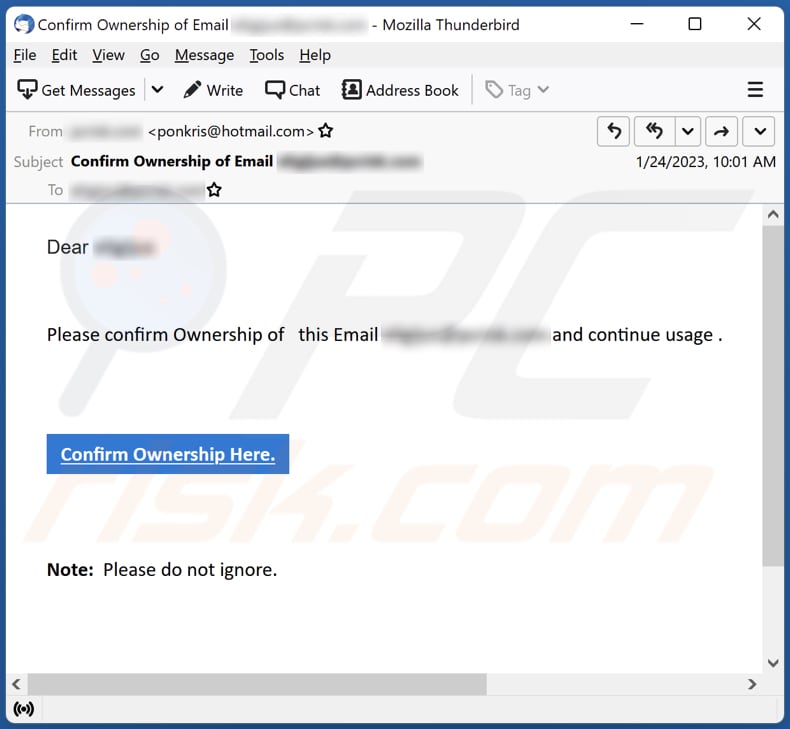
More about the "Confirm Ownership" scam email
This letter is disguised as an email from an email service provider. It instructs recipients to confirm the ownership of their email addresses. Recipients are encouraged to click the "Confirm Ownership Here." button (hyperlink) and asked not to ignore this email.
Clicking the provided button opens a phishing website where visitors are prompted to enter a password to sign in. Scammers use this page to steal login information. They could use the obtained information to access email (and possibly other) accounts.
It is important to mention that scammers usually try to access more than one account with the obtained login information. Thus, users who use the same password for multiple accounts may also lose those accounts.
| Name | Confirm Ownership Email Scam |
| Threat Type | Phishing, Scam, Social Engineering, Fraud |
| Fake Claim | Recipients must confirm the ownership of their email addresses |
| Disguise | Letter from an email service provider |
| Symptoms | Unauthorized online purchases, changed online account passwords, identity theft, illegal access of the computer. |
| Distribution methods | Deceptive emails, rogue online pop-up ads, search engine poisoning techniques, misspelled domains. |
| Damage | Loss of sensitive private information, monetary loss, identity theft. |
| Malware Removal (Windows) |
To eliminate possible malware infections, scan your computer with legitimate antivirus software. Our security researchers recommend using Combo Cleaner. Download Combo CleanerTo use full-featured product, you have to purchase a license for Combo Cleaner. 7 days free trial available. Combo Cleaner is owned and operated by RCS LT, the parent company of PCRisk.com. |
Similar scam emails in general
Typically, scammers behind phishing emails pretend to be real people, legitimate entities, or other entities. Their goal is to lure recipients into providing credit card details, login credentials, social security numbers, ID card information, or other personal details. Phishing emails contain links to deceptive pages or request to provide information directly via email.
Examples of similar scam emails are "Voice Note Email Scam", "Order Information Email Scam", and "Mail Delivery Failed Email Scam". Cybercriminals can also use email to trick users into executing malware.
How do spam campaigns infect computers?
Users infect computers through emails after they open malicious attachments or links (pages that host malware). Malicious files do not always infect computers immediately after opening them. It depends on the file type. For instance, malicious MS Office documents infect computers after enabling macros commands.
Most cybercriminals use malicious MS Office, PDF documents, JavaScript files, executables, ISO files, archives, and other files to distribute malware.
How to avoid installation of malware?
Do not open files or links in emails without being sure it is safe. Download software only from trustworthy sources (official websites and verified stores). Avoid clicking links, pop-up windows, and ads on questionable pages. Keep the operating system and installed programs updated. Use reputed antivirus software.
If you've already opened malicious attachments, we recommend running a scan with Combo Cleaner Antivirus for Windows to automatically eliminate infiltrated malware.
Text presented in the "Confirm Ownership" email letter:
Subject: Confirm Ownership of Email ********
Dear ********
Please confirm Ownership of this Email ******** and continue usage .
Confirm Ownership Here.
Note: Please do not ignore.
Screenshot of the phihsing website promoted via this scam email:
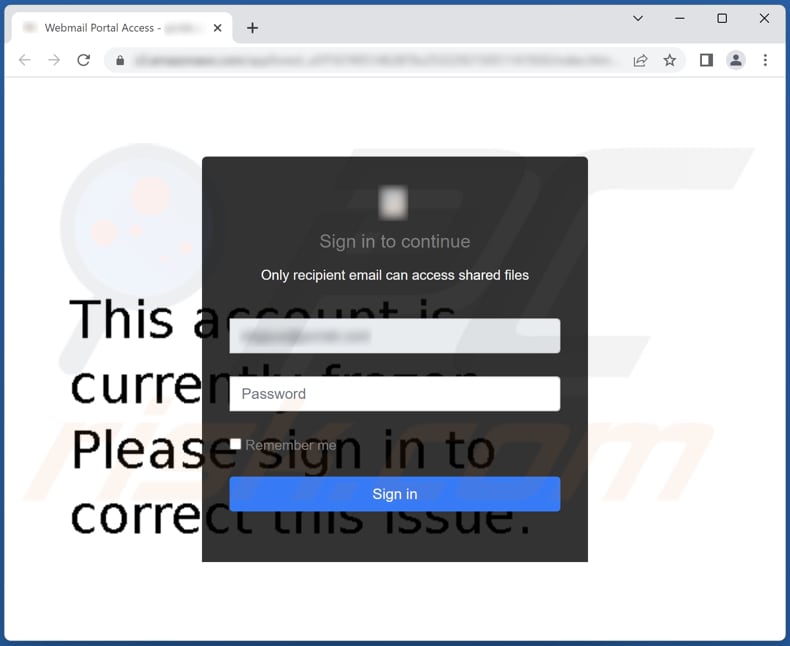
Another example of email ownership confirmation-themed spam promoting a phishing site:
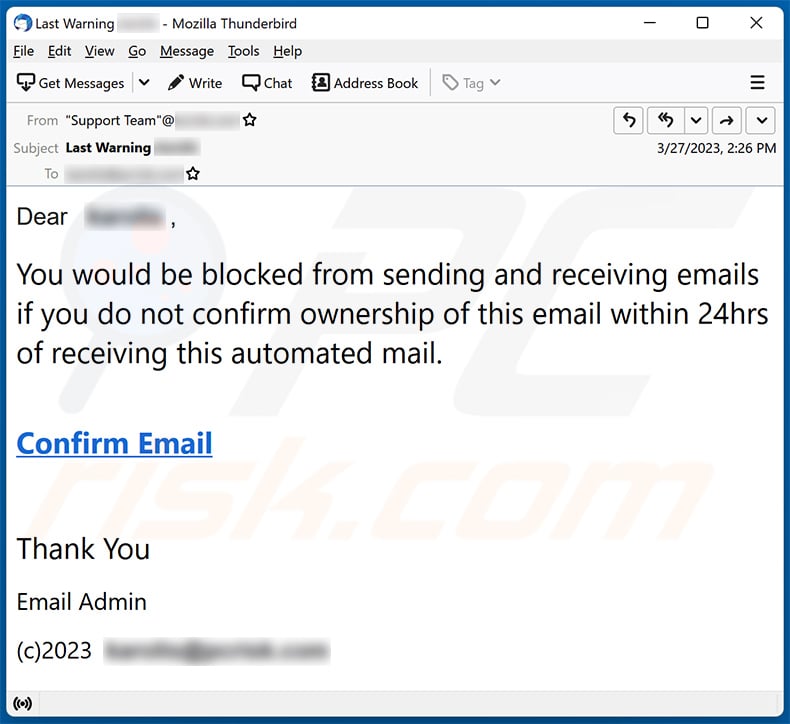
Text presented within:
Subject: Last Warning -
Dear - ,
You would be blocked from sending and receiving emails if you do not confirm ownership of this email within 24hrs of receiving this automated mail.
Confirm Email
Thank You
Email Admin
(c)2023 -
Another example of ownership confirmation-themed spam email promoting a phishing site:
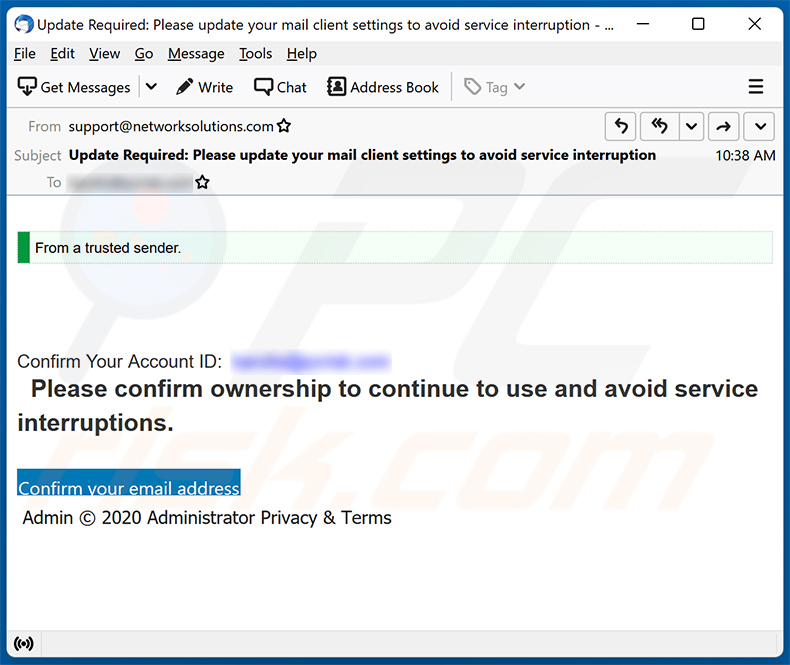
Text presented within:
Subject: Update Required: Please update your mail client settings to avoid service interruption
From a trusted sender.
Confirm Your Account ID: -
Please confirm ownership to continue to use and avoid service interruptions.
Confirm your email address
Admin © 2020 Administrator Privacy & Terms
Another example of email confirmation-themed spam:
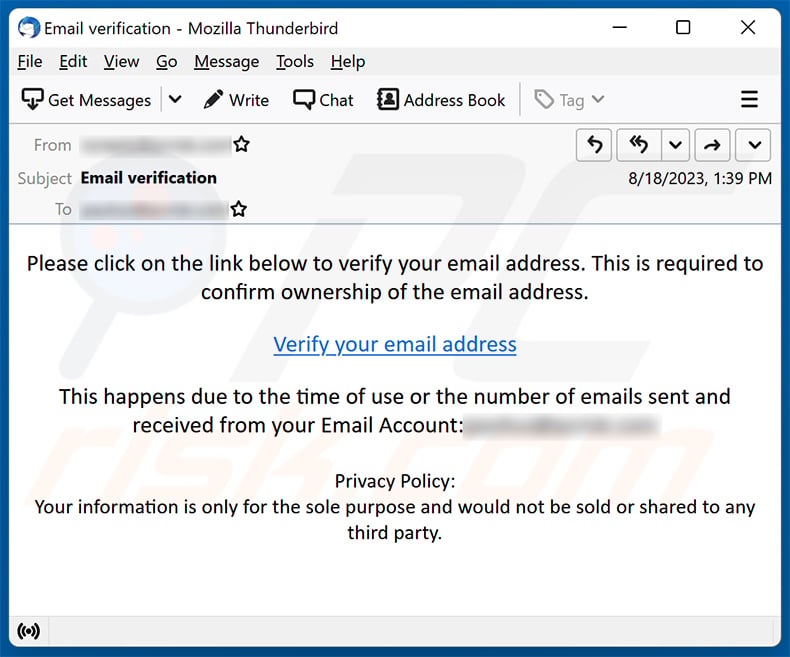
Text presented within:
Subject: Email verification
Please click on the link below to verify your email address. This is required to confirm ownership of the email address.
Verify your email address
This happens due to the time of use or the number of emails sent and received from your Email Account:-
Privacy Policy:
Your information is only for the sole purpose and would not be sold or shared to any third party.
Yet another example of an email ownership confirmation-themed spam:
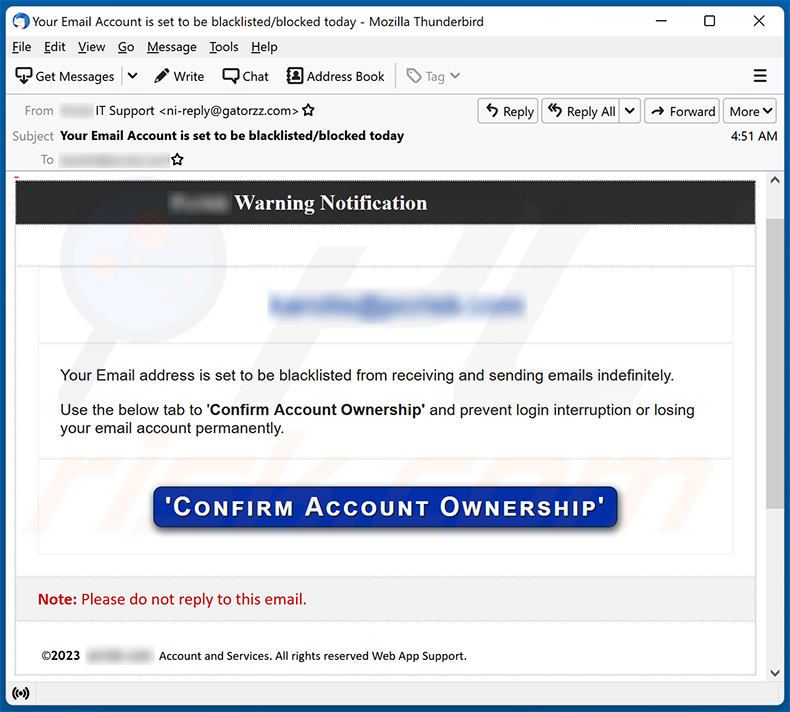
Text presented within:
Subject: Your Email Account is set to be blacklisted/blocked today
******** Warning Notification
Your Email address is set to be blacklisted from receiving and sending emails indefinitely.
Use the below tab to 'Confirm Account Ownership' and prevent login interruption or losing your email account permanently.
'Confirm Account Ownership'
Note: Please do not reply to this email.©2023 ******** Account and Services. All rights reserved Web App Support.
Yet another example of a spam email asking to confirm account ownership:
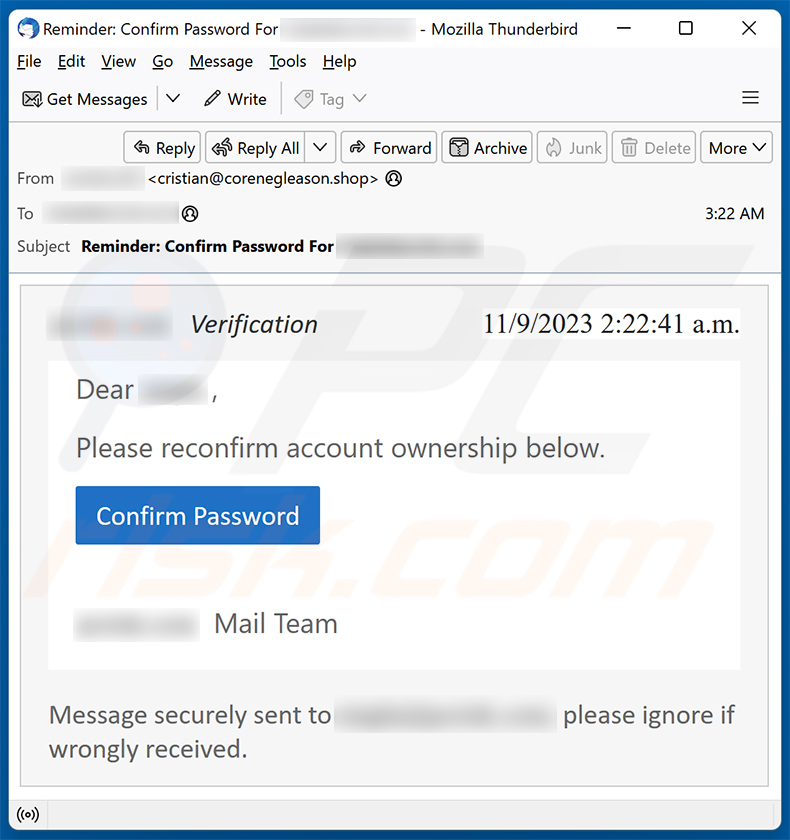
Text presented within:
Subject: Reminder: Confirm Password For ********
******** Verification 11/9/2023 2:22:41 a.m.
Dear ******** ,
Please reconfirm account ownership below.
Confirm Password******** Mail Team
Message securely sent to ********, please ignore if wrongly received.
Another example of an email from "Confirm Ownership" spam campaign:
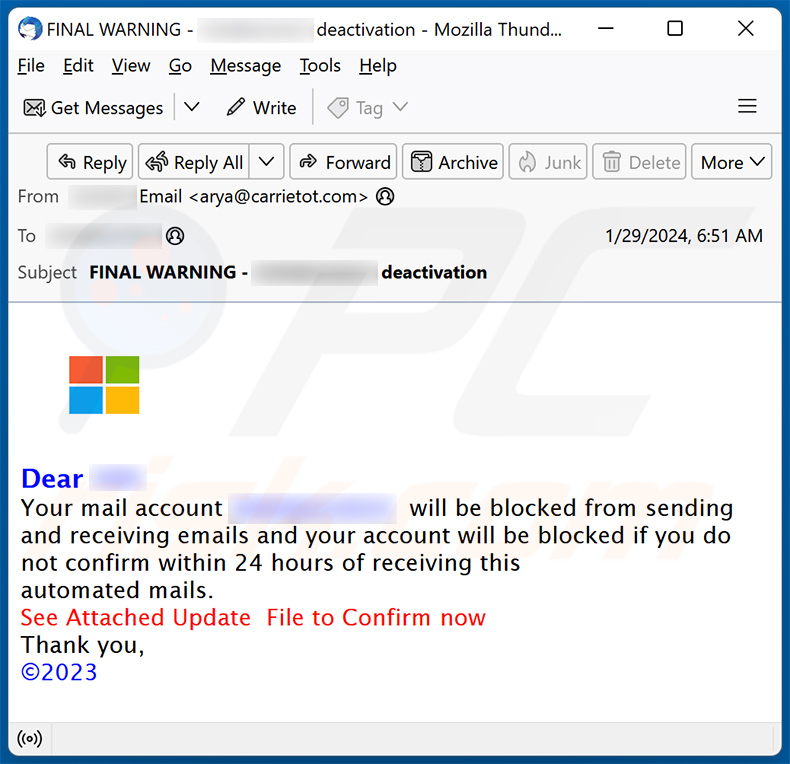
Text presented within:
Subject: FINAL WARNING - ******** deactivation
Dear infoYour mail account ******** will be blocked from sending and receiving emails and your account will be blocked if you do not confirm within 24 hours of receiving this
automated mails.
See Attached Update File to Confirm now
Thank you,
©2023
Screenshot of the promoted phishing site:
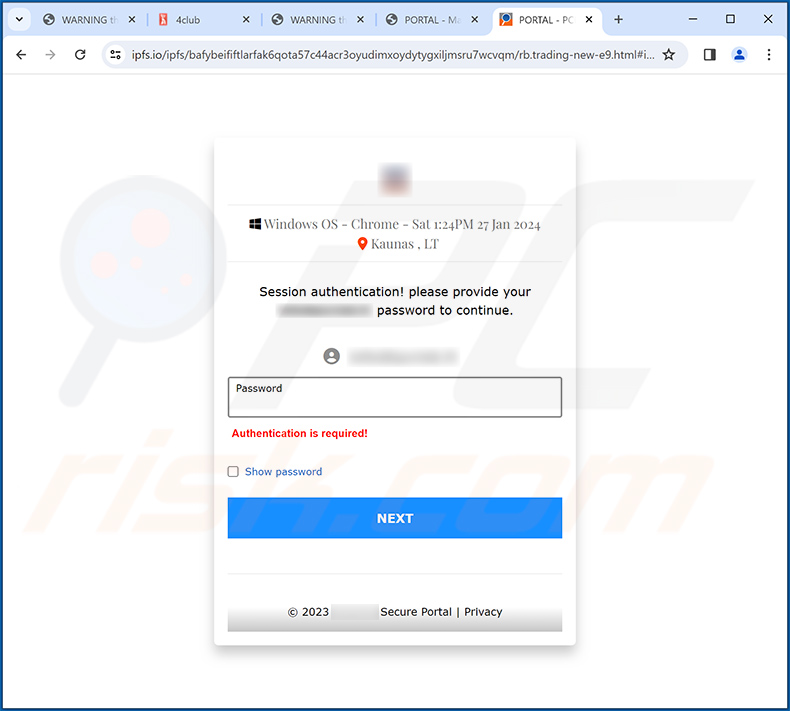
Another example of an email from "Confirm Ownership" spam campaign:
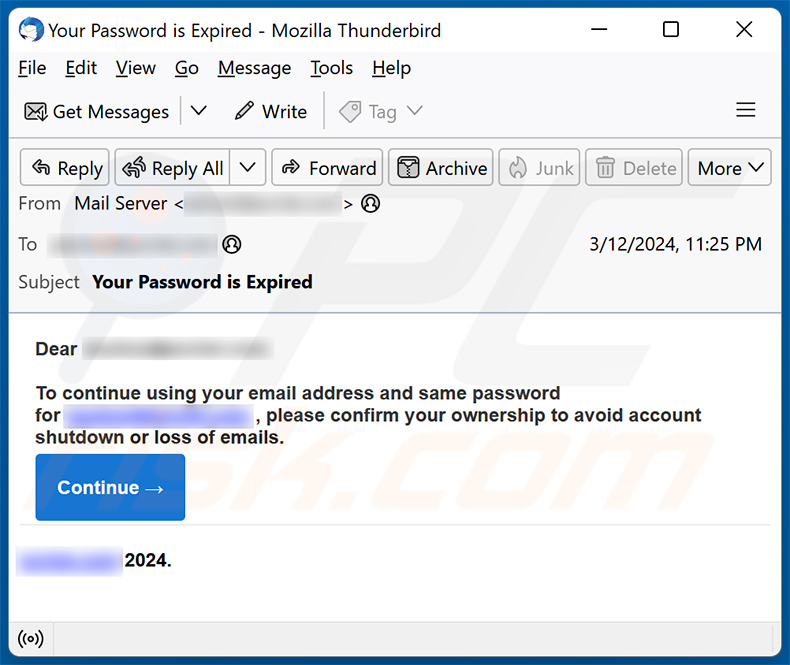
Text presented within:
Subject: Your Password is Expired
Dear ********,
To continue using your email address and same password for ******** , please confirm your ownership to avoid account shutdown or loss of emails.
Continue
******** 2024.
Screenshot of the promoted phishing site:
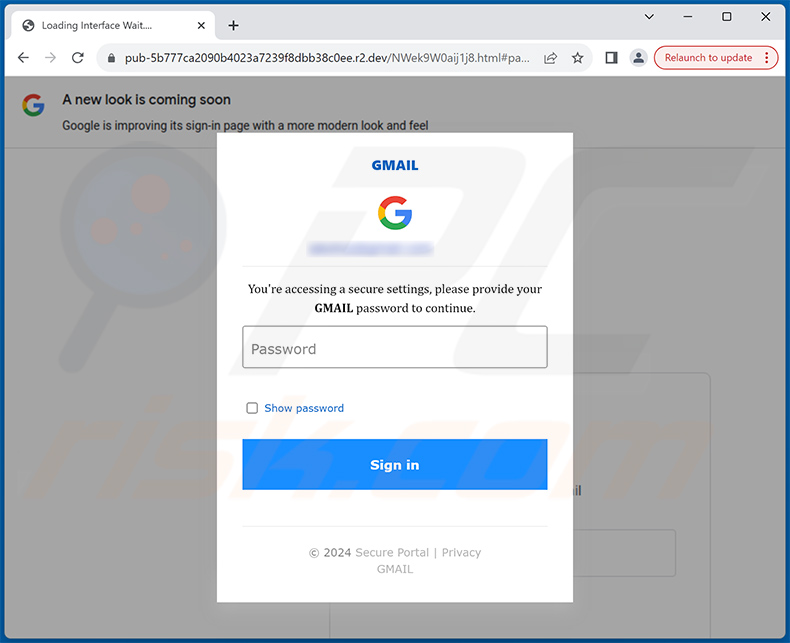
Yet another example of an email from "Confirm Ownership" spam campaign:
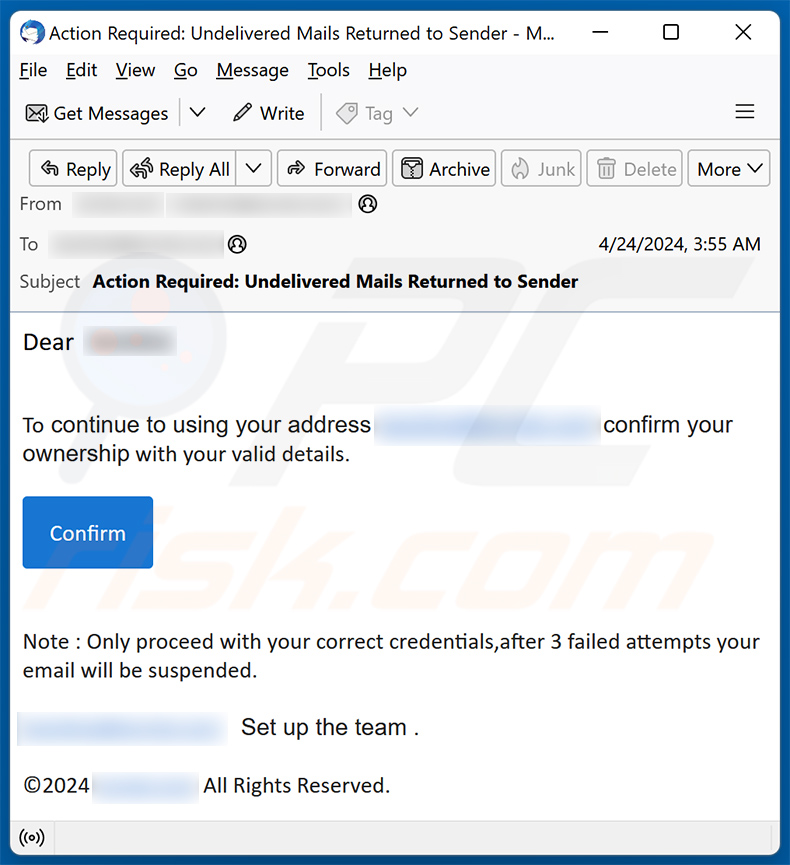
Text presented within:
Subject: Action Required: Undelivered Mails Returned to Sender
Dear -
To continue to using your address ******** confirm your ownership with your valid details.
ConfirmNote : Only proceed with your correct credentials,after 3 failed attempts your email will be suspended.
******** Set up the team .
©2024 ******** All Rights Reserved.
Instant automatic malware removal:
Manual threat removal might be a lengthy and complicated process that requires advanced IT skills. Combo Cleaner is a professional automatic malware removal tool that is recommended to get rid of malware. Download it by clicking the button below:
DOWNLOAD Combo CleanerBy downloading any software listed on this website you agree to our Privacy Policy and Terms of Use. To use full-featured product, you have to purchase a license for Combo Cleaner. 7 days free trial available. Combo Cleaner is owned and operated by RCS LT, the parent company of PCRisk.com.
Quick menu:
- What is Confirm Ownership phishing email?
- Types of malicious emails.
- How to spot a malicious email?
- What to do if you fell for an email scam?
Types of malicious emails:
![]() Phishing Emails
Phishing Emails
Most commonly, cybercriminals use deceptive emails to trick Internet users into giving away their sensitive private information, for example, login information for various online services, email accounts, or online banking information.
Such attacks are called phishing. In a phishing attack, cybercriminals usually send an email message with some popular service logo (for example, Microsoft, DHL, Amazon, Netflix), create urgency (wrong shipping address, expired password, etc.), and place a link which they hope their potential victims will click on.
After clicking the link presented in such email message, victims are redirected to a fake website that looks identical or extremely similar to the original one. Victims are then asked to enter their password, credit card details, or some other information that gets stolen by cybercriminals.
![]() Emails with Malicious Attachments
Emails with Malicious Attachments
Another popular attack vector is email spam with malicious attachments that infect users' computers with malware. Malicious attachments usually carry trojans that are capable of stealing passwords, banking information, and other sensitive information.
In such attacks, cybercriminals' main goal is to trick their potential victims into opening an infected email attachment. To achieve this goal, email messages usually talk about recently received invoices, faxes, or voice messages.
If a potential victim falls for the lure and opens the attachment, their computers get infected, and cybercriminals can collect a lot of sensitive information.
While it's a more complicated method to steal personal information (spam filters and antivirus programs usually detect such attempts), if successful, cybercriminals can get a much wider array of data and can collect information for a long period of time.
![]() Sextortion Emails
Sextortion Emails
This is a type of phishing. In this case, users receive an email claiming that a cybercriminal could access the webcam of the potential victim and has a video recording of one's masturbation.
To get rid of the video, victims are asked to pay a ransom (usually using Bitcoin or another cryptocurrency). Nevertheless, all of these claims are false - users who receive such emails should ignore and delete them.
How to spot a malicious email?
While cyber criminals try to make their lure emails look trustworthy, here are some things that you should look for when trying to spot a phishing email:
- Check the sender's ("from") email address: Hover your mouse over the "from" address and check if it's legitimate. For example, if you received an email from Microsoft, be sure to check if the email address is @microsoft.com and not something suspicious like @m1crosoft.com, @microsfot.com, @account-security-noreply.com, etc.
- Check for generic greetings: If the greeting in the email is "Dear user", "Dear @youremail.com", "Dear valued customer", this should raise suspiciousness. Most commonly, companies call you by your name. Lack of this information could signal a phishing attempt.
- Check the links in the email: Hover your mouse over the link presented in the email, if the link that appears seems suspicious, don't click it. For example, if you received an email from Microsoft and the link in the email shows that it will go to firebasestorage.googleapis.com/v0... you shouldn't trust it. It's best not to click any links in the emails but to visit the company website that sent you the email in the first place.
- Don't blindly trust email attachments: Most commonly, legitimate companies will ask you to log in to their website and to view any documents there; if you received an email with an attachment, it's a good idea to scan it with an antivirus application. Infected email attachments are a common attack vector used by cybercriminals.
To minimise the risk of opening phishing and malicious emails we recommend using Combo Cleaner Antivirus for Windows.
Example of a spam email:

What to do if you fell for an email scam?
- If you clicked on a link in a phishing email and entered your password - be sure to change your password as soon as possible. Usually, cybercriminals collect stolen credentials and then sell them to other groups that use them for malicious purposes. If you change your password in a timely manner, there's a chance that criminals won't have enough time to do any damage.
- If you entered your credit card information - contact your bank as soon as possible and explain the situation. There's a good chance that you will need to cancel your compromised credit card and get a new one.
- If you see any signs of identity theft - you should immediately contact the Federal Trade Commission. This institution will collect information about your situation and create a personal recovery plan.
- If you opened a malicious attachment - your computer is probably infected, you should scan it with a reputable antivirus application. For this purpose, we recommend using Combo Cleaner Antivirus for Windows.
- Help other Internet users - report phishing emails to Anti-Phishing Working Group, FBI’s Internet Crime Complaint Center, National Fraud Information Center and U.S. Department of Justice.
Frequently Asked Questions (FAQ)
Why did I receive this email?
Phishing letters are not personal. All recipients receive the same letters. Usually, scammers use email addresses obtained via untrustworthy pages and addresses leaked in data breaches.
I have provided my personal information when tricked by this email, what should I do?
If you opened a phishing website prompting you to enter your password and clicked a fake "Sign In" button after entering it, change all passwords as soon as possible.
I have downloaded and opened a malicious file attached to this email, is my computer infected?
It depends on the file type. For instance, malicious executables usually infect computers immediately after opening them. However, malicious MS Office documents cannot cause harm until macros commands are enabled.
I have read the email but didn't open the attachment, is my computer infected?
No, opening emails is harmless. Threat actors cannot achieve their goals without tricking users into opening links or attachments.
Will Combo Cleaner remove malware infections that were present in email attachment?
Yes, Combo Cleaner will eliminate malware. It can detect almost all known malware. Since advanced malware usually hides deep in the system, a full system scan is required to detect and remove it.
Share:

Tomas Meskauskas
Expert security researcher, professional malware analyst
I am passionate about computer security and technology. I have an experience of over 10 years working in various companies related to computer technical issue solving and Internet security. I have been working as an author and editor for pcrisk.com since 2010. Follow me on Twitter and LinkedIn to stay informed about the latest online security threats.
PCrisk security portal is brought by a company RCS LT.
Joined forces of security researchers help educate computer users about the latest online security threats. More information about the company RCS LT.
Our malware removal guides are free. However, if you want to support us you can send us a donation.
DonatePCrisk security portal is brought by a company RCS LT.
Joined forces of security researchers help educate computer users about the latest online security threats. More information about the company RCS LT.
Our malware removal guides are free. However, if you want to support us you can send us a donation.
Donate
▼ Show Discussion